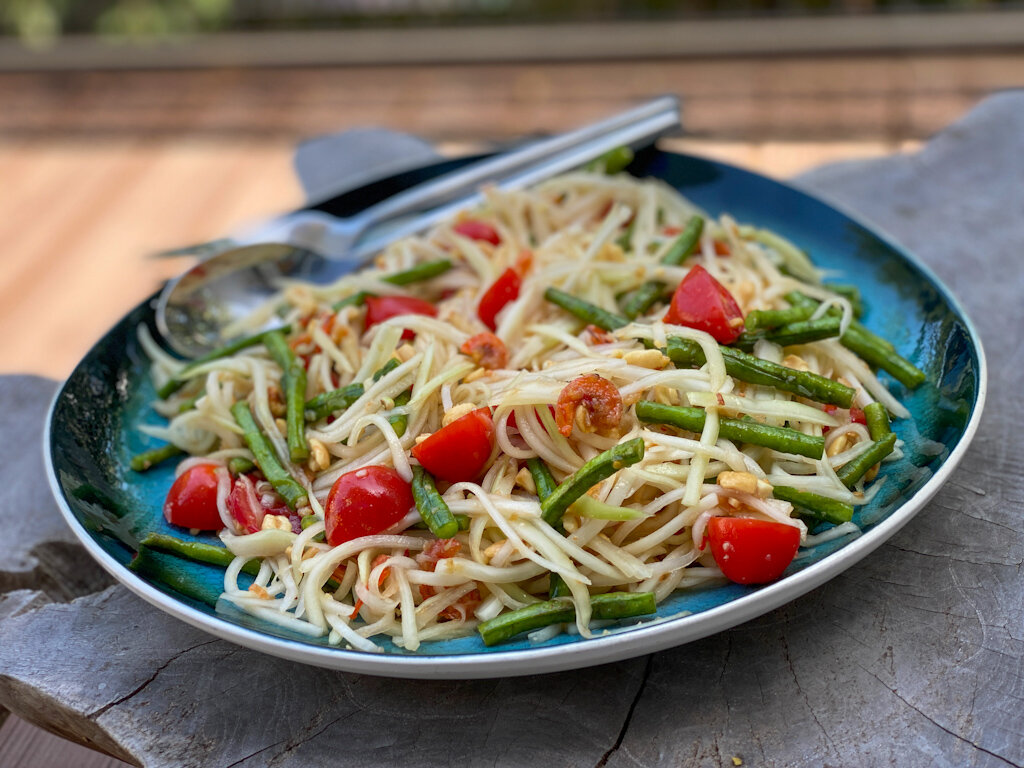Simple Thai Food: Classic Recipes from the Thai Home Kitchen, by Leela Punyaratabandu; photographs by Erin Kunkel; 2014, Ten Speed Press, $24.99.
Backgrounder: Bangkok-born Leela Punyaratabandhu, who now divides her time between Bangkok and Chicago, has written for Serious Eats, Dill Magazine, Food52 and the Wall Street Journal, among others. She launched her Thai cooking blog, She Simmers, in 2008; four years later, it was honored as “Best Regional Cuisine” blog by Saveur. It has been inactive for a few years, though still very much worth reading — especially if you wind up buying Simple Thai Food, her 2014 cookbook, and loving it as much as we do. She has since written two other books, Bangkok and Flavors of the Southeast Asian Grill. We look forward to exploring those. But first things first: Simple Thai Food is life-changingly excellent.
Why we love it: Having spent much of my adult life in places with easy access to outstanding Thai restaurants, I’d never been moved to learn to cook Thai food. Then came the pandemic, and being shut in made me crave its bright, optimistic herbal tang, its lovely perfume of makrut lime leaves and lemongrass. Punyaratabandhu’s slim, 228-page volume makes Thai cooking approachable and accessible. Further, her recipes, though simple to execute (once you get your hands on the right ingredients), look and taste anything but simple; they’re extraordinarily sophisticated, downright impressive, with beautiful layered, balanced flavors.
Punyaratabandhu writes instructions that are not only clear and easy to follow, she also thoughtfully describes exactly the way a dish should look and taste as you cook, helping us appreciate the cuisine as it’s meant to be enjoyed.
Phat Phrik Khing — a dry curry, lightly sweet, of pork and long beans (or in this case, green beans). It is garnished with a chiffonnade of makrut lime leaves.
That is particularly valuable when many of us may be using mediocre Thai restaurant renditions of dishes as yardsticks. “This dish is not supposed to be saucy,” she writes in the instructions for Phat Phrik Khing — a dry curry, lightly sweet, of pork and long beans. “When it looks like a dry curry that glistens with deep orange oil, you know it is done.” In those Americanized Thai places that offer “choice of protein” with this dish, that deep orange oil rarely shows up on the plate.
If you’re like me, you’ll be astounded at how simple it is (again, once you have the key ingredients) to make Tom Yam Kung (hot-and-sour prawn soup) or Tom Kha Kai — Coconut-Galangal Chicken Soup.
Tom Kha Kai — Coconut-Galangal Chicken Soup
Som Tam — the green papaya salad that launched my pandemic Thai cravings — is easy to manage as well. Shredding the green papaya so that it does not bruise is best achieved using a mandoline (great excuse to buy one if you don’t already own one). The author also suggests a hand grater, calling out an inexpensive one called Kiwi Pro Slice.
Som Tam Malako — Green Papaya Salad
Read this first: Buried at the end of the book is Punyaratabandhu’s extremely essential Ingredients Glossary. It’s where I would suggest you start if you want to dive into Thai cooking. In it, the author explains everything you need to know about palm sugar (it’s complicated; if you’re not already familiar with it you might want to stick with her suggested sub of brown sugar. We also used coconut sugar as a sub, with excellent results). She also explains that Thai eggplants may be eaten raw; the differences between Thai basil, holy basi and lemon basil; what to look for when you buy galangal (plus how to freeze it) and how to use makrut lime leaves and rind (and how to freeze them). While we are on the subject, Angkor Cambodian Food is a great source for many of these ingredients. If you think about gathering all your ingredients first, and prep and freeze those that can be frozen, you will be much better off when you finally dive in.
In the glossary, Punyaratabandhu insists on the use of some of these hard-to-source ingredients for particular dishes, and no doubt she’s right in doing so. Happily, she does condone shortcuts when the resulting flavor is acceptable, allowing that commercial Thai curry pastes are far better than homemade ones made with inappropriately subbed ingredients.
You’ve gotta try this: Among the many amazing Thai dishes I made from this book, the one my family was most bowled over by was a sort of dip called Lon Kung Mu Sap, which Punyaratabandhu translates as Shrimp-Coconut Relish with Vegetable Crudités. Basically, it’s chopped shrimp and pork simmered together in coconut milk, brightened with tamarind paste and seasoned with shallot and chiles and garnished with makrut lime leaves.
Leela Punyaratabandu’s Shrimp-Coconut Relish with Crudités (Lon Kung Mu Sap)
“Most people who did not grow up in a Thai household or live with Thai people are unfamiliar with the various coconut milk-based relishes called lon,” she explains in the headnote. She also explains that it is served not before dinner (as a westerner might guess), but along with the rest of the meal. Punyaratabandhu went to to share how she likes to eat it: “I take a piece of the vegetable crudités, put it on a bite’s worth of rice on my plate, top it with a dollop of the lon, transport the whole assembly on a spoon, and eat it in one big bite.”
Thank you for that delicious morsel, dear author.
Dear reader, if you’ve ever been tempted to try your hand at Thai cooking — or if you’ve done quite a bit of it and want a great reference with great recipes — you need this book.





